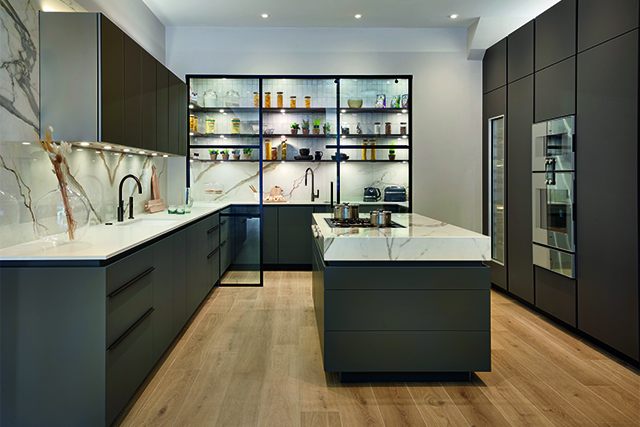
How to design Kosher kitchens
Many know about Kosher dietary laws, but do you know how to design a kitchen so it’s Kosher-friendly? James Kalazois, showroom manager at Poggenpohl Hampstead, outlines the key elements, and why they matter so much.
Planning a Kosher kitchen needs careful consideration for not only the layout, but also the materials chosen – even down to appliances.
Having a showroom on Finchley Road, just a stone’s throw from the London Jewish Centre, Poggenpohl Hampstead and its team of experienced designers often cater for Jewish clients who want a kosher kitchen, and so understanding Kosher requirements are essential for kitchen designers in this area of North London.
A Kosher kitchen typically has two sinks and dishwashers, or separate washing areas, to keep meat and dairy items from mixing
James Kalazois, showroom manager, Poggenpohl Hampstead“Kosher” refers to foods that meet Jewish dietary laws, which include specific rules for the types of meat that can be eaten and how they must be prepared to ensure it meets Jewish dietary requirements (or “kashrut”).
The total separation of meat and dairy produce must be adhered to for those who choose to live a Kosher lifestyle. This can be done in a more relaxed manner, just by making sure that utensils, chopping boards or work-surfaces are separated and only used for either meat or dairy, or for those who choose to adopt all aspects of a kosher lifestyle, it can extend to needing two sets of everything – fridges, freezers, sinks and even ovens.
Navigating the extent to which a Kosher client will want their kitchen segregated is a delicate but essential part of the early design process, to ensure all needs are met and more importantly that the client’s expectations are too.
Worktops are a key consideration. No porous materials can be used, so Corian or a porcelain from Neolith would both be good options – each of which are approved by the Kosher Certification agency, K-Star. Stainless steel, being non-porous again can be used as a work surface and also for a kitchen sink.
For those with space at a premium who cannot fit in two kitchen sinks, stainless steel is a good option as boiling water can be poured into it to cleanse the metal fully, particularly before Passover, to ensure there is no contamination of food types. This is called ‘Kasher’.
Kosher-keeping appliances
Separate ovens, hobs, microwaves, and potentially even refrigerators may be needed for meat and dairy to prevent any cross-contamination. A kosher kitchen typically has two sinks and dishwashers, or separate washing areas, to keep meat and dairy items from mixing.
This is especially helpful for washing dishes separately. Designated countertops and chopping boards for preparing both meat and dairy are necessary, as is the separate storage of these items too.
Indeed, storage considerations are of paramount importance too. In a space large enough, entirely separate cupboards for food storage would be needed, and certainly a second fridge. Drawers for utensil storage must also be considered at the design stage, with two sets of each to be planned into the kitchen.
Many kosher kitchens have two ovens to avoid using one oven for both meat and dairy. If space or budget doesn’t allow this, some people use a single oven for “pareve” (free from both meat and dairy) foods only, and then invest in meat and dairy countertop appliances.
Some appliance manufacturers offer a “Sabbath mode” that keeps lights off and disables automatic shut-off for ovens and other appliances, making them compliant with Shabbat regulations. Miele ovens have a programme where the oven stays on for 72 hours.
This allows clients to be able to slow cook food during periods of religious observance. In the Jewish faith, you are to rest on the Sabbath (the seventh day), and so for those observing this aspect of their faith, they should not be cooking.
Warming drawers are also an ideal addition in planning a kosher kitchen, as they can keep food at a certain temperature. Re-heating food is also forbidden on the Sabbath. Separate burners on a hob may also be designated for meat and dairy, so specifying hobs with enough rings or plates must be considered too.
Space solutions
Many Kosher customers also need large storage areas for a wide range of smaller cooking appliances, as well as food processors and mixers, as they may choose to have two sets of these items to ensure compliance. This would also extend to the storage of dishcloths, tea towels, sponges and any other items used for cooking or cleaning.
Often, Kosher kitchens have two sinks, or a double sink so that meat and dairy items don’t mix when washing. Some even go as far as to install two taps to avoid contact between the water and the two food types.
Ultimately, space is the number one pre-requisite for a fully Kosher-compliant kitchen. Ensuring total segregation of meat, dairy and pareve foods needs space to offer different work surfaces, sinks, ovens and fridges – not to mention the storage of duplicated small appliances, crockery, cutlery and serving dishes.
Whether it’s for Rosh Hashanah, Yom Kippur or Passover, Jewish communities gather to eat and celebrate together, so beyond the essentials listed here, there also needs to be direct access to a large communal area or dining space in order to break bread, and end fasting, together.

